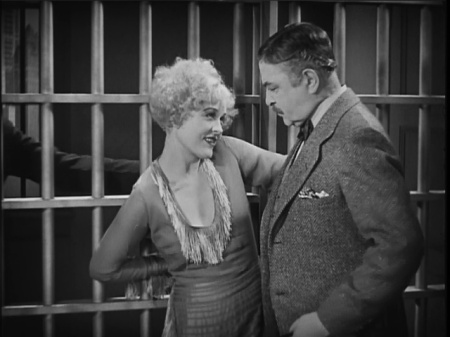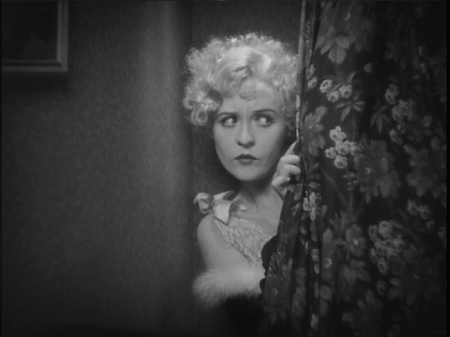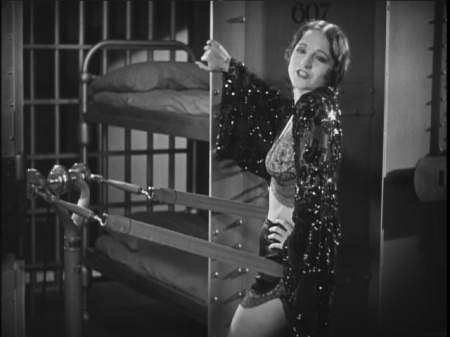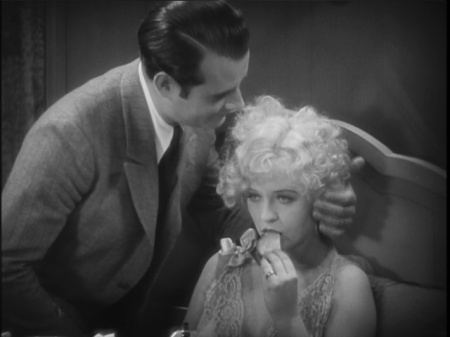Think of Chicago as a 1970s or 2000s musical? Think again! The original play by Maurine Watkins was filmed twice sans musical numbers, once as a silent and once as a talkie. The story of murderesses and corruption is juicy, the behind-the-scenes action is just as intriguing.
I will also be covering the 1942 talkie remake, Roxie Hart. Click here to skip to the talkie.
Home Media Availability: Released on DVD.
Eat your heart out, Bob Fosse.
Seventy-five years before it was released as an Oscar-winning musical, Chicago was a sassy silent film created by Cecil B. DeMille’s production company. It boasted a brilliant turn by Phyllis Haver as the heartless Roxie and, just to make things yummier, it was secretly directed by Mr. DeMille himself!
Cecil B. DeMille’s foray into independent production was a mixed bag, both financially and artistically. DeMille personally directed four films for his company between 1925 and 1929. His first and last, The Road to Yesterday and The Godless Girl, were disappointments at the box office but The Volga Boatman and King of Kings both made handsome profits.
Under the studio system, most production companies would divide their budgets between expensive prestige pictures and cheaper programmers. The program pictures were not meant to be masterpieces, just enjoyable trifles that could be churned out quickly to pay the bills. (Of course, some of these programmers were masterpieces but that is a different story.)
The program pictures were what sunk DeMille. They did not boast his name as director but they were, as programmers went, on the pricy side. In the 1925-26 fiscal year, the DeMille company released ten program pictures and only two turned a profit. The 1926-27 financial reports are incomplete but it seems that only one picture turned a profit out of the sixteen released. In the final fiscal year for the company, 1927-28, the programmers were doing better with twenty-five films released and fourteen showing a profit.
(If you wish to know more about the business side of DeMille, I highly recommend Cecil B. DeMille’s Hollywood by Robert S. Birchard.)
The DeMille programmers may not have been the biggest hits of their day but they are extremely beloved in silent film circles. Titles like Eve’s Leaves, Rubber Tires, The Clinging Vine, The Cruise of the Jasper B… Many of these movies are sassy and fast-paced, ideal for modern viewers and those high budgets ensured top-notch production values.
The most successful of these films was Chicago. In fact, it grossed nearly as much as DeMille’s personally-directed release, The Godless Girl, and on less than half the budget.
So, other than being DeMille’s top-grossing program picture, what makes Chicago so special? Well, we have to bring up King of Kings to answer that question. DeMille was the son of an playwright/Episcopal lay preacher and an actress/agent. He inherited his mother’s flamboyant personality and boldness and his father’s religiosity and hairline. DeMille is often the subject of scorn due to his love of decadent sin mixed with extreme piety but this strange blend does accurately reflect his personal taste. He loved trash and religion with equal fervor.
(If you wish to know more about the personal side of DeMille, I highly recommend Empire of Dreams: The Epic Life of Cecil B. DeMille by Scott Eyman.)
King of Kings was meant to be a respectful version of the life of Jesus. It grossed 2.6 million dollars, an immense sum in those days, and was DeMille’s biggest hit to date.
In the meantime, DeMille’s production company had obtained the rights to the hit play Chicago. As most of you know, the plot involves adultery, murder and other sinful happenings. This perfectly suited DeMille’s predilections, especially coming off the extremely proper King of Kings. It would have been an ideal holiday for him.
This is where we slide into speculation. The story (borne out by an item in Picture Play magazine and correspondence with Sid Grauman) is that DeMille did not dare follow up King of Kings with a film version of the wildest play in town. Frank Urson, DeMille’s assistant on his personal productions, was the sole credited director but DeMille did most of the actual directing.
Another fact supports this scenario: DeMille kept every film he directed in his personal film vault. Of all the dozens of films released as programmers and specials under the DeMille banner, there was only one movie found in that personal vault that did not have DeMille as the credited director. You guessed it, that movie was Chicago.
(In fact, Chicago was thought lost for years before being found in the DeMille collection and restored in 2006.)
Internal records from the production indicate that DeMille took over direction of the film on or before the seventh day of filming. He also directed eleven days of retakes and all memos regarding the film were routed to him.
Frank Urson’s solo directing efforts are not easy to come by. I have only seen an incomplete print of Her Man O’ War, released just one year before Chicago. While that film is certainly fascinating for its gender relations (an article is forthcoming), it shows none of the stylish flourishes that make Chicago so good. However, DeMille’s 1927 film The Godless Girl shows a similar flair to Chicago and has parallels in content if not tone. I believe that DeMille was entranced by Chicago‘s seedy plot and stepped in when it was obvious that Urson was in over his head.
Here is the story: Roxie Hart (Phyllis Haver) is the apple of her husband’s eye. Amos Hart (Victor Varconi) is a mild-manner tobacconist who adores his wife so much that he does all the housework, gives her breakfast in bed and occasionally pauses to… nuzzle her jingle-bell garter? Hmm.
Anyway, Roxie has expensive taste and the cigarette store that Amos owns is just not enough to give her what she wants. So, she has taken a well-to-do lover. Rodney Casley (Eugene Pallette) enjoyed Roxie’s company for a time but the bills for couture gowns and French perfume have become too much and he dumps her.
Roxie takes the news about as well as you might expect and puts a bullet through Casley. Now she’s in a fix. She’s in her apartment wearing, er, abbreviated attire with a dead body and a gun. What to do? Call Amos, naturally.
Roxie tells Amos that Casley was a burglar. Amos realizes the lie when he discovers a distinct jingle-bell garter in the dead man’s pocket. However, he loves Roxie too much to let her be arrested and tries to confess to the police. The district attorney (Warner Richmond) sees through the deception and Roxie is arrested.
That’s where the press comes into it. Roxie is a knockout and she can sell papers by the thousand with her picture and a caption that reads, “Chicago’s most beautiful murderess.” Roxie is thrilled by the attention and happily plays along.
Amos, meanwhile, is trying to find a way to free Roxie. He tries to hire Flynn (Robert Edeson), the crookedest, winningest lawyer in Chicago, but the fee is $5,000. That’s $67,000 and change in 2014 money.
Roxie, meanwhile is enjoying her time in prison. She busily clips news stories and pictures about her case. Velma (Julia Faye) is the previous murder queen and she is contemptuous of her new rival. She and Roxie end up getting into a catfight. (The fight is yet another reason to believe that DeMille directed the film.)
A desperate Amos ends up burgling Flynn’s place to get the money for Roxie’s defense. It turns out to be cash well spent. Flynn is a brilliant liar and manipulator. He fine-tunes Roxie’s story. She was defending her honor! They both grabbed for the gun!
Chicago moves along at a rapid clip, though things do slow down in the middle act when we are shown more Amos and less Roxie. Things pick right up again in time for the trial. The courtroom scenes are the showstopper of the film. Edeson and Haver play off one another extremely well and the jury’s reactions to Roxie are worth the price of admission.
Phyllis Haver was a veteran Sennett Bathing Beauty but she was also an extremely talented actress. She captures the infantile (and homicidal) personality of Roxie to perfection. You can just see the wheels turning in Roxie’s dim little brain as she tries to both save herself and gather up fame. Edeson is equally well-cast as the crooked Flynn.
Eugene Pallette is another treat. In his brief but memorable role as the future stiff, he hits all the right notes. He is a blustering, arrogant fellow who is smarter than Roxie and thinks he is in control of the relationship. Think again, bub!
Victor Varconi, on the other hand, is a bit limited. Granted, Amos is hardly the most interesting or sympathetic character. He spends half the film being an utter doormat and doesn’t really grow a spine until near the end. By then, I had lost interest in whether or not he stays with Roxie. Plus, Mr. Varconi seems to have only two expressions in this picture: Garter Nuzzler and Very Annoyed.
Doubtlessly as a concession to the censors, the character of Katie (Virginia Bradford) was added to Chicago. She is the neighbor and cleaning woman who has a crush on Amos. You know, a better, more virtuous lady for our sucker husband. Frankly, her inclusion is a bit ham-fisted and she never really seems to fit into the story.
Still, the many strong performances more than make up for the weak ones.
An aspect of Chicago that is particularly fun to modern viewers is how very, very twenties it is. Phyllis Haver prances around in tacky dresses festooned in beads, fringe and feathers. Julia Faye makes her appearance wearing a rhinestone-spangled lingerie set. The characters play around with Kewpie dolls, player pianos and ukuleles. Red hot jazz is most certainly the order of the day.
As for the adaptation, I am generally very pleased. The film has a flabby middle section but the first and third acts are absolutely stunning. The murder and aftermath are black comedy gems while the climactic courtroom scenes are wonderful bits of satire. (DeMille always did do well with courtroom scenes.)
DeMille’s decision to eschew credit for directing Chicago may have been wise in the short term but in the long run, it would have been better if he had put his name above the title. Thanks to some corny sound films, DeMille’s reputation is in tatters. Chicago showcases the silent DeMille that I adore. It’s saucy, snappy and completely irresistible.
Movies Silently’s Score: ★★★★
Where can I see it?
The gorgeous restored version was released on DVD by Flicker Alley. The film features a jazzy score by the Mont Alto Motion Picture Orchestra and the DVD also includes the documentaries The Golden Twenties and The Flapper Story.
Silents vs. Talkies
Chicago (1927) vs. Roxie Hart (1942)
Chicago was remade fifteen years later as Roxie Hart. The country was different and nowhere was it more obvious than in the movies. While DeMille had to make some concessions to the censors, he was still able to get the story of Roxie more or less accurately filmed. In 1942, the Code was at its strongest and Chicago had dozens of strikes against it.
Adultery unpunished? A murderess gets off? All those garter belts and negligees? No, no, no!
In the plus column, Roxie Hart is directed by William Wellman and it boasts the talents of Ginger Rogers and silent veteran Adolphe Menjou. Will their skills be enough to save the day or is a defanged Chicago doomed? Let’s find out!
Roxie Hart is told in flashback. It opens with a gaggle of reporters bemoaning the lack of good murders (Roosevelt apparently being responsible) and longing for the bad old days of the 1920’s when there were some real killings.
The murder that the reporters loved the most was the case of Roxie Hart. A veteran newsman, Homer (George Montgomery), narrates her tale. Of course, she didn’t actually kill anyone (what would Joseph Breen say?), her husband did. She takes the blame, though, because she thinks it will help her showgirl career. 1927 Roxie was dumb but wily. 1942 Roxie… well, let’s just say that if she ever had a thought, it would die of loneliness. In spite of all this and in spite of the fact that Roxie is married, Homer falls head over heels for her.
The script tries to evoke the roaring twenties period by throwing out names and phrases rapidly: Teapot Dome, Black Bottom, Coolidge, Capone! It’s the twenties! Do you get it? Do you? A few of the phrases are cute but it gets old very quickly. And it keeps going throughout the whole film. “Golly, gee, are we ever in the twenties! I may just have to Charleston all the way over to my sheik’s speakeasy but I got to see a flicker first because I carry a torch for John Gilbert, see?” It’s especially distracting to hear this “atmosphere-building” chatter right on the heels of seeing the real thing.
While the 1927 version proudly wears its notoriety on its sleeve, the 1942 version seems to be a little bit embarrassed by it. The catfight in the jail is a perfect example. It’s a funny scene, two grown women fighting over who is the more notorious (and who has more cosmetic enhancements), and the reaction of the prison matron is the punchline. (You can’t act the way you do at home!) In the 1942 version, some bright boy thought it would be a swell idea to add, you guessed it, the sound of cats yowling over the fight. Needless to say, the audience is pulled out of the reality of the picture.
The other problem is Amos. Pervy milquetoast though he was in the original, his motivation for raising the money to save Roxie was quite clear. In the remake, Amos blames Roxie for the murder he committed and is hesitant to hop on the publicity gravy train. Why is he so willing to hand over every penny he has to Flynn?
The single biggest flaw, though, is in the title character. By turning Roxie into a sweet but dumb kid, the satire loses its bite. Smart writing might have papered over the issue but the script simply makes Roxie a non-murderess and then goes on its merry way without altering much else. I really expected more from an adaptation by Nunnally Johnson. (Ben Hecht is often listed as an uncredited screenwriter on the film but that seems unlikely as no internal documents exist to support this claim and Johnson, a friend of Hecht, denied his involvement.)
The seams really show when Two Gun Gertie (Iris Adrian) appears. A gangster in blue jeans, Gertie guns down a cop at a filling station and steals Roxie’s thunder. Gertie is such a colorful, nasty character that the tepid writing of Roxie is even more obvious. The press abandon Roxie for Gertie and, frankly, I wanted to go with them.
Both films have compromise endings. The 1927 version ends with Roxie acquitted but dumped by Amos, who, it is hinted, will soon take up with sweet Katie. The 1942 version also ends with an acquittal and the revelation that Roxie gave up her pursuit of fame and showbiz to marry Homer. Interestingly, Roxie is shown with six or seven kids (and more on the way) and looking none too happy. A subtle dig at the American Dream ending that the film got saddled with?
Now shall we crunch some numbers? Let’s compare the cast of the two versions and see who comes out on top:
Roxie: While Ginger Rogers is a good actress, the ambitious but dim version of Roxie that she is saddled with limits her enormously and she overcompensates with some atrocious mugging. Phyllis Haver, on the other hand, was given the full-blown murderess and the juiciness of the part makes all the difference. A point to the silent.
Amos: Do we go for the boring guy with the garter fixation or the rat who sells his wife up the river and then whines about it? Well, trapped between these two unappealing choices, I am going for Victor Varconi’s Amos as his character’s motivations at least made some semblance of sense. Another point to the silent.
Flynn: Robert Edeson is excellent and he would have handily won if he had been going against anyone else but Adolphe Menjou. Menjou’s Flynn is absolute perfection. In fact, he almost saves the film. Almost. A point to the talkie.
Velma: Along with Flynn, Helene Reynolds’ Velma is probably the character with the fewest alterations between the 1927 and 1942 versions. However, Julia Faye’s Velma shows up wearing a black lace brassiere and takes her scene by storm. There’s no beating that. A point to the silent.
The superfluous law and order love interest: Virginia Bradford’s Katie and George Montgomery’s Homer are both dull as dishwater but you can sort of understand Katie more than Homer. The 1927 Amos is a fairly stupid guy caught in a bad marriage who just needs some looking after. The 1942 Roxie is a coarse dimbulb with a tendency toward both violence and adultery but without the brains or the ambition to actually finish what she started. Ideal housewife material in Homer’s eyes, apparently. Another point to the silent.
And the winner is… The Silent
A wild play like Chicago simply was not meant for the uptight 1940s. While the filmmakers try to compensate for the lack of an actual murderess, the whole thing comes tumbling down when the script crumbles under the weight of its alterations.
While Adolphe Menjou definitely makes the talkie worth seeing, the plot is an anemic shadow of its former self.
Availability: Roxie Hart is available on DVD.
☙❦❧
Like what you’re reading? Please consider sponsoring me on Patreon. All patrons will get early previews of upcoming features, exclusive polls and other goodies.
Disclosure: Some links included in this post may be affiliate links to products sold by Amazon and as an Amazon Associate I earn from qualifying purchases.






















Roxie Hart was never going to work with Ginger Rogers in the title role. I turned off after 15 minutes…many moons ago!
It was definitely a challenge to get through. I mean, how do you make a movie about a murderous wild girl without any wildness– or murder? 😉
Any film set in the 1920s made during the 1940s or 1950s is usually awful. Those decades were too, as you say, “straight-laced.”
That’s true. Also, I think it was such recent history to the filmmakers that historical research went right out the window.
I agree. As far as I can tell, “Singin’ in the Rain” does the 20s well, though, but it still does make some mistakes.
Also not a huge Singin’ in the Rain fan. (Attacked by angry Gene Kelly fans)
I was fortunate to see this on the big screen with live accompaniment by the great Ben Model. The audience was delighted and the restored print was gorgeous. And I thought Varconi was kinda cute….. This is a fun film and a great representation of what folks would leave their homes for on a Saturday night.
What fun! This film is definitely on my “big screen” wish list.
Loved this review. Also, really love the comparison series. Had no “Chicago” was a play had the two movie adaptions before the musical and Best Picture winner. I’ll be reviewing the 2002 film eventually for my Best Picture series, so I’ll be sure to include this information. The silent does look really good. Will put it on my list of films to see.
Oh, out of curiosity, have you ever done a post comparing the 1923 DeMille “Ten Commandments” and the 1956 “Ten Commandments?”
Glad you liked it!
No, I have not yet tackled The Ten Commandments. I am not an enormous fan of the 50’s version so I am not sure it would be a fair fight. 😉 I sometimes avoid Silents vs. Talkies features if I take an initial, strong dislike to the talkie (for example, Captain January) as I know the silent will win right off the bat.
Oh, and you’re comment on the 40s version being so, “Hey it’s the 20s!” is the same problem I have with a lot of movies set in the 50s. It can be hard to do sometimes but too many films shove the period in your face too much.
Lazy writing, I think. Instead of trying to absorb the attitudes and real slang of the period, some take the shortcut of pop culture references.
Right-o, daddy-o! Let’s get some coca-cola to go with our poodle skirts and coonskin caps and twist our way over to the James Dean flick because this is THE FIFTIES! (It really, really is)